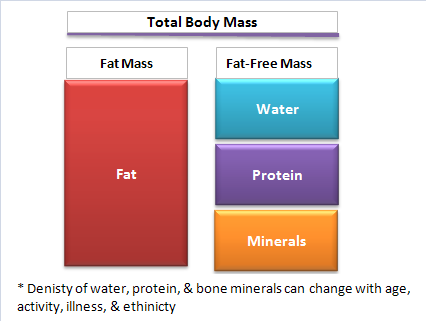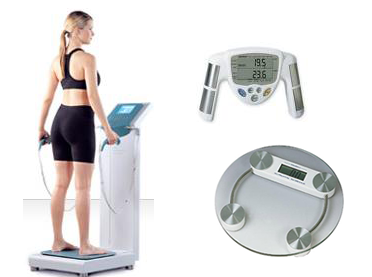Anatoly | Tue September 08, 2009
“Click here to find your BMI”
I guess the link has been lost.
P.S. Great article, Anoop

September 08 2009
I get often asked about the most accurate body measurement method/calculator. Here we will look at the common body fat percent measurement methods to find the most accurate one
Body Mass Index (BMI) is just simply weight (kg) divided by height (msquare) and is often used to classify people into categories based on disease risk. Click here to find your BMI
Problem 1. BMI just assumes your body be a tub of fat. So if you are an athlete or someone who lift weights, it just ignores all that hard-earned muscle and might classify as “overweight or obese”. How unfair is that?
Just to be sure, BMI do not estimate bodyfat. Equations are being developed to estimate bodyfat from BMI but the current equations have large errors (>5%) in estimating bodyfat.
Underwater weighing is considered as the Gold Standard among body fat measurement methods/calculators. It is based on the fact that density of muscle is higher than fat and hence muscle sinks and fat floats.
Problem 1. It is based on a two-component model and hence divides your body into two compartments: Fat Free Mass & Fat Mass. Fat free mainly mass includes bone, muscle, water (also glycogen, soft tissues) apart from body fat as shown below.

* Figure shows a two-compartment model and how it divides total body mass.
It assumes fat free mass and fat mass to have a constant density. But it is pretty clear that the density of your muscles and bones do change depending on age, illness, activity, and ethnicity.
If you are 18 and lift weights, your bone and muscle density will be a lot different from a 45 year old sedentary individual.
Problem 2. Fat-free mass is made up of proteins, water, & bone minerals. So if you drink a lot of water before measuring, it can’t help but think it is all muscle (lucky you).
Hydrostatic weighing is used as a standard to even validate other bodyfat measurement techniques. Now tell me how screwed up is that?
Skin calipers measures the fat under the skin (subcutaneous) in certain areas to estimate bodyfat. It assumes that subcutaneous fat is proportional the fat inside your body.
Problem 1.Body fat distribution & how well it correlates with the fat inside your body varies based on age, fatness levels , physical activity, and genetics. Some might have more on the thighs whereas others on their abs.
Problem 2. It is based on a two compartment model and hence also has all the problems mentioned above.
Problem 3. There are equations which measures skin thickness from 3, 7, & 9 sites. But, generally, as the measurements increases so does the errors.
BIA is based on the fact that muscle is 72% water and hence is less resistant to the flow of current than fat. Usually BIA is measured by attaching electrode to your wrist and feet and passing a current through.

* Picture shows BIA with electrodes connected and the commonly used hand held & scale BIA.
Problem 1. As you might have guessed everything from drinking a lot of water, emptying your bowels, having more salt in your diet, having a high- carb diet can change the water levels, and along with it your bodyfat.
Problem 2. The commonly seen hand held or scales are called segmental body fat analysers -measures one half of the body -and the equations used in these are yet to be validated.
Problem 3. Since they are based on a two-compartment model they suffer from all the problems associated with a two compartment model.
DEXA is slowly replacing to be the gold standard for body composition methods. DEXA is based on a three-compartment model than a 2-compartment model. It can measure the density of fat, bone minerals, and water & protein combined.
Problem 1. This is lot more accurate than the two compartment models but still assumes the density of water & protein. It also has a lot more assumptions which are too technical to make any sense.
Anatoly | Tue September 08, 2009
“Click here to find your BMI”
I guess the link has been lost.
P.S. Great article, Anoop
Anoop | Wed September 09, 2009
Thanks Anatoly. I fixed the link.
Jeremy | Sun September 13, 2009
What about the BodPod? Is that a good body fat calculator? My college has one and they charge $30.00 to use it. What do you think?
BTW, nice article!
Anoop | Mon September 14, 2009
Hi Jeremy,
I used BODPOD for my Master’s thesis. BODPOD is based on volume displacement just like underwater weighing. The only difference is that BODPOD uses air instead of water.
It is a lot easier to use BODPOD and you don’t have to worry about going underwater like hydrostatic. But it is a two compartment model and has all the assumptions and errors associated with a two compartment model.
Thanks Anoop.
What about DEXA? I thought it was the most accurate out there.
Anoop | Fri October 09, 2009
Hi Jacob,
DEXA is not the be all end all of body fat measurements, though many people think that way.I just didn’t want to write too much and drag the article.
DEXA assumes the hydration status to be 73% but it can vary from 73 to 87% and hence changes in hydration can throw off the readings. The hydration status depnds on both extracellular and intracellular water. Different manufacturers of DEXA use different algorithms to distinguish betwaeen fat and fat free mass. The greater the depth of the tissue to be scnned the greater the errors in DEXA because of the attenuation of the photon beam.
The advantage is DEXA is that it is accessible, less invasive, and use a 3 compartment model than the 2 -compartment models we commonly use.
Any comment on the formulae based on circumference measurements (waist and often neck and/or hip, in addition to height and weight)? For example, the US Navy formula.
Anoop | Fri January 01, 2010
Hi Tim,
The advantage is that it is pretty easy and can be used on a lot of people in a short time. The downside is the validity.
The military circumference equations have been shown in a number of studies to read the body fat to be pretty high. Unfortunately, they are still used to determine if someone is compliant and usually has to face disciplinary actions if they are not.
It you need some numbers, the military equations read 3-5% higher than skinfold measurements.
hope it helps
Milwaukee Personal Injury Lawyer | Tue December 14, 2010
I’m glad you pointed out the problems with skin calipers. The genetics part never occurred to me. Even so I am going with the idea that Calipers will acurately track my body fat when used consistantly by the same technician as you pointed out. I prefer that to getting in a tub of water.
Hi there
I read this site with great interest.
Any comments on the new Fresenius BCM, used for dialysis patients.
It reports that it measures ICW and ECW directly therefore giving a better estimate of overhydration?
Debra Monaco | Wed August 31, 2011
I had liposuction on my thighs, butt and midsection in 2000. I looked great at the time, but now I have gained 25lbs in weird places…(breast and upper abdomen, arms and face). Would the underwater method be the best for me?
Anoop | Thu September 01, 2011
Hi DEbra,
I would say either underwater or DEXA.
brian | Fri September 09, 2011
BIA and skin calipers may be unreliable when you have muscle imbalances especially upper body vs legs.
I have a very slender upper body like that of a girl, and bulky legs like that of a sprinter. Kind of looks like a woman because my waist it results in curves. Using BIA, I’ve measured 8% fat using my legs, and 20% using my upper body.
In this case, hydrostatic weighing is preferred. Doesn’t DEXA use x-rays?
Anoop | Mon September 12, 2011
Thanks Brian for the comment. Good point. Individual regional differences in body fat can screw up some of the results. There are whole body BIA which can show body fat percentages on your limbs and truck separately.
Whatever body fat you use, it should only be used a reference point. There is no real practical purpose of knowing bodyfat ‘accurately’.
Cowgirl | Thu October 13, 2011
I’ve recently had this performed. I’m a female athlete, 5’6”, weigh about 147, and have a BMI around 24. I wear a size 6. This machine calculated 35% body fat, but by caliper, I’m at 26. We should not rely on machines to tell us whether or not we’re healthy.
So you got a lower result so you like it better and assume it is more accurate. typical. you probably got the dodge machine though. good ones are up the back =D
© 2008 - 2025 | Exercise Biology. All rights reserved.